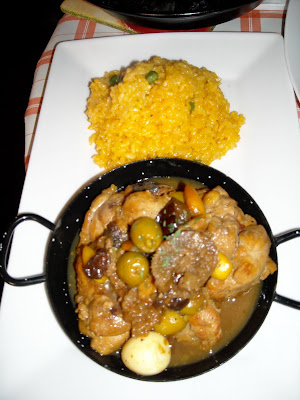
Visitors to A Happy Home in Itaewon are greeted by a cacophony of African dialects bouncing off the walls of the small restaurant. Most of the guests were not eating when I arrived on a recent Monday night (and all were male), but the restaurant seems to serve as a meeting place where they can go for lively conversation as well as a taste of home when the mood strikes. My soft-spoken waiter asked if I wanted to move to an inner room away from the large group of men whose shouts indicated that their conversation had briefly turned into a friendly argument, but I assured him that I was fine.
The restaurant is sorely lacking in atmosphere in one sense; the walls are a dingy white, the florid magenta chairs look out of place, and a large screen TV takes up one wall. On the other hand, the place still manages to feel cozy and well-used because of the friendly service and the clientele who have clearly made it a second home. It's not a date destination, but could be a nice place for a relaxed lunch with friends.
I didn't have any experience with West African food prior to my visit, but I'm always looking to expand my palate. When I asked my waiter for advice, he smiled and looked a bit befuddled. "You want something authentic?" he finally asked while staring at the menu on the wall, and I assured him I did. He continued to look equally skeptical and amused, but recommended the first or second meal on the list. I opted for number two, the egusi with a side of fufu, because...well, I had no idea what I was doing, and it looked as good as any.

While waiting for my meal to arrive, the men's booming voices caused my book to vibrate and the occasional names and English snippets I heard made me wish I could understand their conversation; there were a lot of references to the United States, Pablo Escobar, and, most mysteriously, "the dolphin with the top speed in the world." Sadly, I will never know how this fit into the conversation or why it was the only phrase said in English.
Just before my meal arrived, a smiling woman sat down at the table next to me and started watching American Idol on the TV in front of us. When my food--a vivid orange ugesi soup with beef chunks, greens and a side of fufu--landed on the table, she asked me if I needed a fork to eat it or if I would be okay with just a spoon. I told her a spoon was fine, but wasn't I supposed to dip the fufu into the soup by hand anyway? She replied that in Africa it is eaten by hand, but it was fine for me to use a spoon. I dug in, first with my fingers and then a spoon when I realized I had no idea how to manage the large chunks of meat. The medley of spices was pleasant and piquant, and especially tasty combined with the chunks of beef. I asked the woman next to me what was included in the dish and she wrote down the ingredients, most of which could be found in any curry. The one unique ingredient that I'm assuming gave the meal its distinct taste was the egusi that it's named after, a powder made from melon seeds.
Overall, the dish was simultaneously familiar and exotic to me. My only complaint was an aftertaste that reminded me of liver, which is one of the few foods I'll probably never enjoy. There was just a hint of it, but it was enough to prevent me from ordering the dish in the future. Instead, I'm looking forward to trying other entrees on the menu.
 (I apologize for the poor picture quality, but I only took a couple of discreet snaps because I didn't want to feel like even more of an outsider than I already was.)
(I apologize for the poor picture quality, but I only took a couple of discreet snaps because I didn't want to feel like even more of an outsider than I already was.)Subsequent internet research has revealed that I completely botched my first fufu experience. When I finished my soup, there was still half a portion of it left. The thought of consuming straight lumps of thick, gooey starch was incredibly unappealing and I left it on my plate, but when another woman arrived and asked her friend quietly why I hadn't finished my meal, the woman who'd helped me replied that I'd asked for the ingredients in the soup and seemed to enjoy it. Since I was clearly within ear range, I looked at the woman and exclaimed that the food had been excellent, but I didn't have enough room to finish the fufu on its own. I should have forced it down, though, as I was clearly being scrutinized and also because I've since found out that it's extremely laborious to prepare. As if leaving half of it on my plate weren't bad enough, it is evidently an insult to the cook to chew fufu instead of swallowing it whole, and I was practically treating the stuff like bubble gum. As an inhabitant of a country not my own, I am used to eating under a microscope(after all, that's why I ate kimchi every day for a year before I actually started to enjoy it), and I should have been better prepared for the Happy Home experience. Food is an extension of hospitality and a symbol of pride, so next time I will swallow my own along with sticky mouthfuls of fufu.


























